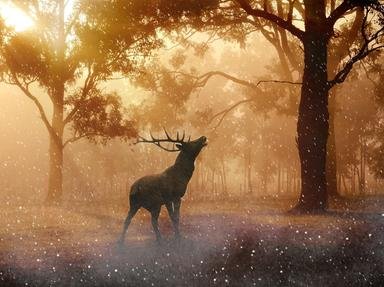Quiz Answer Key and Fun Facts
1. As mentioned in the introduction, camelids are even-toed ungulates. Ralph the llama deduces from this that all members of his family have an even number of toes, but the rest is lost on him. He visits great uncle Deputygary to elaborate on this term. Great uncle Deputygary tells Ralph that even-toed ungulates make up the order Artiodactyla and he begins to list several members of this order. Which of these relatives is Deputygary unlikely to mention?
2. Feeling that great uncle Deputygary is going off on a tangent, naming countless distant relatives, Ralph the llama now saunters along to cousin Jabberwok's. She has promised him a good meal, but Ralph is not entirely sure what he is going to be given - a large pancake? Or maybe spaghetti bolognaise? If she wants to serve proper llama food, what is cousin Jabberwok most likely to serve to young Ralph upon his arrival?
3. Nice and full from his meal, Ralph the llama now begins to wonder more about his immediate family. With this in mind, you accompany him to visit his father, Glendathecat. Ralph's dad tells him many stories about their family - some are well behaved and keep themselves to themselves, but some are a bit wild. Which of these camelids is regarded as wild, rather than domesticated?
4. Due to a broken leg, Glendathecat tells Ralph that he is unable to visit cousin Baban in Peru and so offers Ralph the ticket. You and Ralph are supposed to be meeting cousin Baban at Lima International, but have never met her before. Cousin Baban is an alpaca, so what should you be looking for?
5. Cousin Baban tells you and Ralph more about the camelid family during your visit to Peru. She tells you about great aunt Exit10 and how she has the hump. However, cousin Baban does not mean Exit10 is grumpy, but that she is a dromedary and so possesses ONE hump. Which type of camel typically possesses TWO humps?
6. Ralph the llama takes you to his next relative, uncle MIMO. Having done much research into the "family tree," MIMO begins to tell you that the camelid family originated from the North American continent. Is there still a wild population of camelids on the continent today?
7. MIMO tells you and Ralph the llama about a bone which was found at a Wal-Mart construction site in 2007. What was significant about this discovery?
8. As mentioned earlier in the quiz, many camelids have been domesticated and so can perform specific jobs. Cousin Kyle tells you about how llamas can be used for a special purpose in North Carolina, just off of the Blue Ridge Mountains. What is this special job?
9. Still a bit curious about those "wild" members of the camelid family Glendathecat mentioned earlier, you and Ralph decide to go and meet Ralph's wacky aunts, Flopsy and PDAZ, the guanacos. In which South American country are you unlikely to find Flopsy and PDAZ causing mischief?
10. Your final visit is to Ralph's Grandparents, Mikejamillon and Qoolgal. They tell Ralph that when he and his cousins (the alpaca, vicuna and guanaco) were younger, they had a special nickname for them - the same nickname many others give to these animals. What was this nickname?
Source: Author
doublemm
This quiz was reviewed by FunTrivia editor
crisw before going online.
Any errors found in FunTrivia content are routinely corrected through our feedback system.

